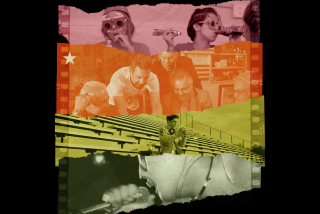DANCE / GRUPO FOLKLORICO TEPEYAC : Watch Their Steps : Members of the troupe, whose fame is spreading, are put in touch with their cultural roots and identity.
- Share via
In a whirlwind of color and sound, the Grupo Folklorico Tepeyac dancers sweep onto the stage. Their feet fly in fancy steps accenting the beat of the music. Their ribbon-adorned skirts flash rainbow colors.
The Mexican dance company is rehearsing for its three shows on Tuesday, Cinco de Mayo, two of which are not open to the public and will be held at schools in Fillmore and Santa Paula. The other will be at Ventura College. Although Tepeyac is based in Santa Paula, the group’s fame is spreading beyond Ventura County. Members recently participated in the 10th International Mariachi Conference in Tucson, Ariz.
“We’re a darned good group,” director Maria Saiz said, crediting teacher and choreographer Jesus Gonzales with instilling discipline. “He drives us to our max. He wants us to do it right.”
Yet no one complained at the fast-paced rehearsal that left dancers drenched with sweat as they drilled toward perfection.
“It’s a natural high,” Tino Lopez said.
“When I dance, I feel vivacious,” said Lopez’s sister Gloria Lopez.
“As soon as I hear the music, I feel it in my heart,” added Amelia Lopez, the third sibling. All three, in their early 20s, have been dancing since they were children.
The Lopezes and some of the other dancers said they enjoy Mexican dancing because it puts them in touch with their cultural roots and identity.
Gonzales teaches out of love for Mexican dance. “I hear the music and it’s like dancing in my blood; it’s all over my body,” he said, his feet moving even as he talked.
Tepeyac, formed in 1987, has 20 members, all volunteers, ranging from their preteens to their 30s. Almost from its inception, the group began winning competitions, including a Ventura County Fair talent show and a folklorico contest at the Los Angeles Coliseum.
All of the dances originate in seven regions of Mexico. They are authentic, but are choreographed or adapted to fit the performing space and the number of dancers.
“It’s a constant thinking process and a challenge,” Saiz said. “You have to keep a smile on your face, look like you’re in love with your partner, and concentrate on the steps and your skirt and the music.”
The style of the skirts, by the way, is integral to the performance. They are typically floor length and full circle with deep ruffles, and are used for flirting or hiding behind for a feigned kiss.
Costumes from Jalisco are multi-hued with ribbon borders, or with sequins for the Mexican Hat Dance. Dresses of Vera Cruz, white with lace, show a Spanish influence. The costumes of Chiapas are in black silk with large, bright flowers embroidered on the skirts and off-the-shoulder blouses.
For Jalisco dances the men wear black charro pants and short jackets. They top it off with a felt sombrero, weighing about two pounds, with a brim measuring nearly three feet across. Silver botonadura, double buttons connected by short chains, run the length of the pant legs, adding about another three pounds to the costume.
Dancers’ boots and shoes have small nails on the bottom to enhance the sound of soles striking the wooden floor.
For all the time and effort members devote, “the prize is to wear these beautiful costumes and to be able to perform these colorful dances,” Saiz said. “That’s the climax of it all.”
The detailed outfits contribute to the romance of the performance. In Mexican dances, “the guy has to be a man, a macho man, and the lady has to be a lady, nice, like a flower,” said choreographer Gonzales, who is a dentist by profession.
Tepeyac’s show at Ventura College will be in keeping with the group’s usual shows. It regularly performs at schools and community functions.
“They’re a great group of local people and we’re grateful they’re available. If they weren’t, we’d have to import performers from L.A. or elsewhere,” said Mayo de la Rocha, Mexican-American history instructor at Ventura College and co-organizer of the program. “They’re very professional, but they take time to perform in the community.”
Anyone interested in Mexican dance can join Tepeyac at no cost, but participants must be willing to attend rehearsals twice weekly. Most members participate as a cultural expression, but some teen-agers have an additional reason for dancing.
“If I get mad that same day and I come to practice, it makes me feel better,” said Polo Chavez, 15.
WHERE AND WHEN
Grupo Folklorico Tepeyac will dance Tuesday at 10:30 a.m. at the Ventura College outdoor stage. The performance is free and the public is welcome on campus. For information, call 525-1230.
More to Read
The biggest entertainment stories
Get our big stories about Hollywood, film, television, music, arts, culture and more right in your inbox as soon as they publish.
You may occasionally receive promotional content from the Los Angeles Times.










